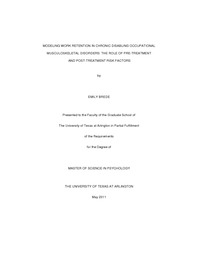
ATTENTION: The works hosted here are being migrated to a new repository that will consolidate resources, improve discoverability, and better show UTA's research impact on the global community. We will update authors as the migration progresses. Please see MavMatrix for more information.
Show simple item record
| dc.contributor.author | Brede, Emily | en_US |
| dc.date.accessioned | 2011-07-14T20:53:53Z | |
| dc.date.available | 2011-07-14T20:53:53Z | |
| dc.date.issued | 2011-07-14 | |
| dc.date.submitted | January 2011 | en_US |
| dc.identifier.other | DISS-11102 | en_US |
| dc.identifier.uri | http://hdl.handle.net/10106/5836 | |
| dc.description.abstract | Chronic pain has become an increasing problem, with serious social and economic consequences. One important socioeconomic outcome in the treatment of chronic disabling occupational musculoskeletal disorders (CDOMD) is work retention (WR), which reflects the patient's ability to both obtain and maintain employment following treatment. A consecutive CDOMD patient sample received complete physical and psychosocial evaluations at admission to and discharge from a functional restoration program, and WR was evaluated one year later. It was hypothesized that the effect of economic and psychosocial factors at admission on WR would be mediated by those same factors at discharge . A structural equation model was developed which included age; work status, government disability benefits, opiate dependence, perceived disability, and depressive symptoms at admission; and work status and perceived disability at discharge. Physical, psychosocial, and economic factors at admission and discharge interact to determine the maintenance of functional gains during the year following discharge. | en_US |
| dc.description.sponsorship | Gatchel, Robert J. | en_US |
| dc.language.iso | en | en_US |
| dc.publisher | Psychology | en_US |
| dc.title | Modeling Work Retention In Chronic Disabling Occupational Musculoskeletal Disorders: The Role Of Pre-treatment And Post-treatment Risk Factors | en_US |
| dc.type | M.S. | en_US |
| dc.contributor.committeeChair | Gatchel, Robert J. | en_US |
| dc.degree.department | Psychology | en_US |
| dc.degree.discipline | Psychology | en_US |
| dc.degree.grantor | University of Texas at Arlington | en_US |
| dc.degree.level | masters | en_US |
| dc.degree.name | M.S. | en_US |
Files in this item
- Name:
- Brede_uta_2502M_11102.pdf
- Size:
- 959.2Kb
- Format:
- PDF
This item appears in the following Collection(s)
Show simple item record


